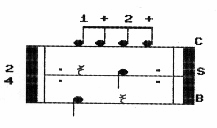





|
By 
Jeremy "JD" Sheehan LESSON 3 
"TIME SIGNATURES" The following material assumes you are familiar with measures, barlines, tempo, and rests.
-----Time Signatures are represented in the form of a fraction, such as 4/4, and let us interpret notes in different values.
The most important thing to remember is that the relationship of notes to each other never changes. This means that a whole
note always breaks up into 2 half notes, or 4 quarter notes, or 8 eighth notes, or 16 sixteenth notes, or 32 thirty-second
notes. A quarter note always breaks up into 2 eighth notes. An eighth note always breaks up into 2 sixteenth
notes. A sixteenth note always breaks up into 2 thirty-second notes. -----The value of each note in relation to other notes is always the same. The time signature tells you how to interpret the note. In a time signature, the top number tells you how many beats are in a measure. The bottom number tells you which note receives 1 beat. The easiest way to remember the bottom number is the number on the bottom is equal to the note that fits into a whole note that amount of times. -----So in the time signature of 4/4, the top 4 tells us that there are four beats in a measure. The bottom 4 tells us which note receives 1 beat. Which note fits into a whole note 4 times? The quarter note does. The quarter note receives 1 beat, which means the 8th note receives 1/2 beat, the 16th note receives 1/4 beat and the 32nd note recieves an eigth of a beat. Remember, the value of notes to each other is constant.
-----The first time signature we will learn other than 4/4 is 2/4 time. The only difference is that there are 2 beats per measure.
All note values are the same as in 4/4 time.
-----Here is an example of the previous 4/4 drumbeat written in the time signature of 2/4. Notice it plays exactly the same but must be repeated to equal the same time as the 4/4 beat.  Hear the above rhythm ( 4 measures of beat )
-----The second figure in 2/4 will be the use of the single stroke roll in tempo. This figure is written in 2/4 time as 16th notes.
You could also play it in 4/4. Play this figure with alternating strokes, RLRL, and play the bass drum on the count of 1.
Also play it with the bass on 1 - 2 . Try to increase your speed. Next we will connect it with the drumbeat we learned to
form a "fill".
 Hear the above rhythm ( 4 measures of roll )
-----We will now connect the sixteenth note roll to the drumbeat to form a "fill". Watch your tempo and don't rush the "fill".
The bass drum should remain at the same tempo and play the same pattern.
 Hear the above rhythm ( 2 measures drumbeat with fill )
-----We will now make a "2 bar phrase" by connecting together the drumbeat and fill with another measure of drumbeat
Again, the bass drum plays the same pattern repeated across both measures.
 Hear the above rhythm ( 2 bar phrase of drumbeat with fill ) |









|